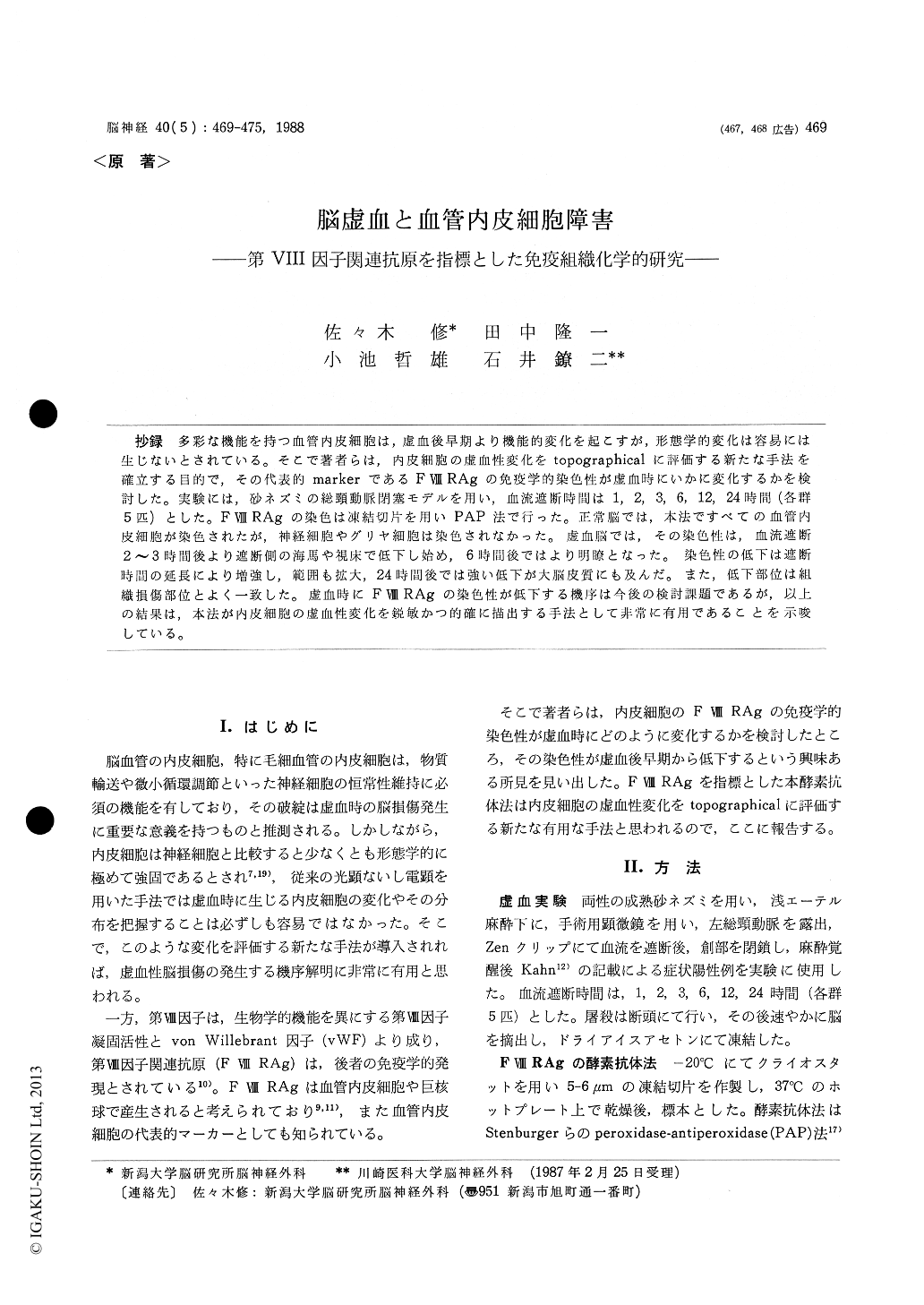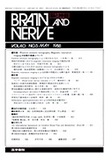Japanese
English
- 有料閲覧
- Abstract 文献概要
- 1ページ目 Look Inside
抄録 多彩な機能を持つ血管内皮細胞は,虚血後早期より機能的変化を起こすが,形態学的変化は容易には生じないとされている。そこで著者らは,内皮細胞の虚血性変化をtopographicalに評価する新たな手法を確立する目的で,その代表的markerであるF VIII RAgの免疫学的染色性が虚血時にいかに変化するかを検討した。実験には,砂ネズミの総頸動脈閉塞モデルを用い,血流遮断時間は1,2,3,6,12,24時間(各群5匹)とした。F VIII RAgの染色は凍結切片を用いPAP法で行った。正常脳では,本法ですべての血管内皮細胞が染色されたが,神経細胞やグリヤ細胞は染色されなかった。虚血脳では,その染色性は,血流遮断2〜3時間後より遮断側の海馬や視床で低下し始め,6時間後ではより明瞭となった。染色性の低下は遮断時間の延長により増強し,範囲も拡大,24時間後では強い低下が大脳皮質にも及んだ。また,低下部位は組織損傷部位とよく一致した。虚血時にF VIII RAgの染色性が低下する機序は今後の検討課題であるが,以上の結果は,本法が内皮細胞の虚血性変化を鋭敏かつ的確に描出する手法として非常に有用であることを示唆している。
As brain capillaries do various works necessary for maintaining the homeostasis of neurons, their disruptions may play an important role in the establishment of ischemic brain damage. It is also said that brain capillaries response to ischemia more functionally than structurally and their microstructural features remain unchanged for a long time of ischemia. Therefore, a new method is expected to be introduced that can evaluate the ischemic changes of endothelial cells on a histological level more sensitively than conven-tional histological methods. In the present study we investigated immunohistochemical reactivity of factor VIII related antigen (F VIII RAg), a specific and representative marker of vascular endothelial cells, in normal and ischemic brains.
In the experiment, cerebral ischemia was induced by occlusion of the unilateral common carotid artery in adult mongolian gerbils. The periods of occlusion were 1, 2, 3, 6, 12, and 24 hours, in five animals respectively. After occlusion each brain was obtained by decapitation and quickly frozen at-80℃ and 5-6μm sections were cut in a cryostat at-20℃ and dried at 37℃. The staining for F VIII RAg was done by the peroxidase-antiperoxidase method using specific antiserum to human F VIII RAg
In normal gerbil's brains, the positive staining for F VIII RAg was observed in endothelial cells ofarteries, veins and capillaries. In major vessels the staining was intense, but neurons and glia were not stained.
In ischemic brains, the staining for F VIII RAg of endothelial cells began to decrease slightly in the hippocampus and thalamus in the occluded side 2~3 hours after occlusion, and the decrease became more evident at 6 hours of occlusion. The staining intensity was decreased proportionally to the time period of occlusion, and the areas of damage also expanded. At 24 hours of occlusion marked decrease in staining was shown not only in the basal ganglia but also in the cerebral cortex. The degree and extent of endothelial cell damages observed by the present method was in good accordance with those of tissue damages estimated by H&E stain.
The mechanism and meaning of the decreased staining for F VIII RAg in ischemic brains are not clear. However, it has been shown that a Ca++influx induces a rapid release of F VIII RAg from cultured endothelial cells and a decrease in its immunohistochemical reactivity at the same time. Therefore, it seems likely that the decreased reactivity may represent a disturbance in calcium homeostasis in endothelial cells.
The present study has revealed that the immuno-histochemical method to F VIII RAg is an indirect but an useful method that make us possible to estimate the ischemic endothelial cell changes more sensitively and exactly on a histological level.

Copyright © 1988, Igaku-Shoin Ltd. All rights reserved.


